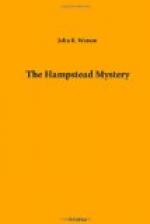Inspector Chippenfield, who realised that the important position the prisoner occupied at the bar added to the importance of the officer who had arrested him, gave evidence as to the arrest of the prisoner at his chambers in the Middle Temple. With a generous feeling, which was possibly due to the fact that he was entitled to none of the credit of collecting the evidence against the prisoner, Inspector Chippenfield allowed Detective Rolfe a subordinate share in the glory that hung round the arrest by volunteering the information in the witness-box that when making the arrest he was accompanied by that officer. He declared that the prisoner made no remark when arrested and did not seem surprised. Mr. Walters produced a left-hand glove and witness duly identified it as the glove which he found in the room in which the murder took place.
Inspector Seldon gave formal evidence of the discovery of the body of Sir Horace Fewbanks on the 19th of August. Dr. Slingsby repeated the evidence that he had given at the trial of Birchill as to the cause of death, and was again professionally indefinite as to the length of time the victim had been dead when he saw the body. Thomas Taylor, taxi-cab driver, gave evidence as to driving the prisoner from Hyde Park Corner on the night of the 18th of August and the finding of the glove.
Crewe went into the witness-box and swore that on the second day after the discovery of the murder he was present at Riversbrook when the prisoner visited the house and saw Miss Fewbanks. When the prisoner arrived he was not carrying a walking-stick, but he had one in his hand when he took his departure from the house. Witness followed the prisoner, and a boy who collided with the prisoner knocked the stick out of his hands. Witness picked up the stick and inspected it. He identified the stick produced in court as the one which the prisoner had been carrying on that day.
The most difficult, and most important witness, as far as new evidence was concerned was Alexander Saunders, a big, broad red-faced Scotchman, whose firm grasp on the tam-o’-shanter he held in his hand seemed to indicate a fear that all the pickpockets in London had designs on it. With great difficulty he was made to understand his part in the witness-box, and some of the questions had to be repeated several times before he could grasp their meaning. Mr. Lethbridge humorously suggested that his learned friend should have provided an interpreter so that his pure English might be translated into Lowland Scotch.
By slow degrees Saunders was able to explain how he had found the pocket-book which Sir Horace Few-banks had lost while shooting at Craigleith Hall. Witness identified a letter produced as having been in the pocket-book when he found it. The letter, which had been written by the prisoner to Sir Horace Fewbanks, urged Sir Horace to return to London at once, as if he did so there was a good possibility of his obtaining promotion to the Court of Appeal. The writer promised to do all he could in the matter, and to call on Sir Horace at Riversbrook as soon as he returned from Scotland.




